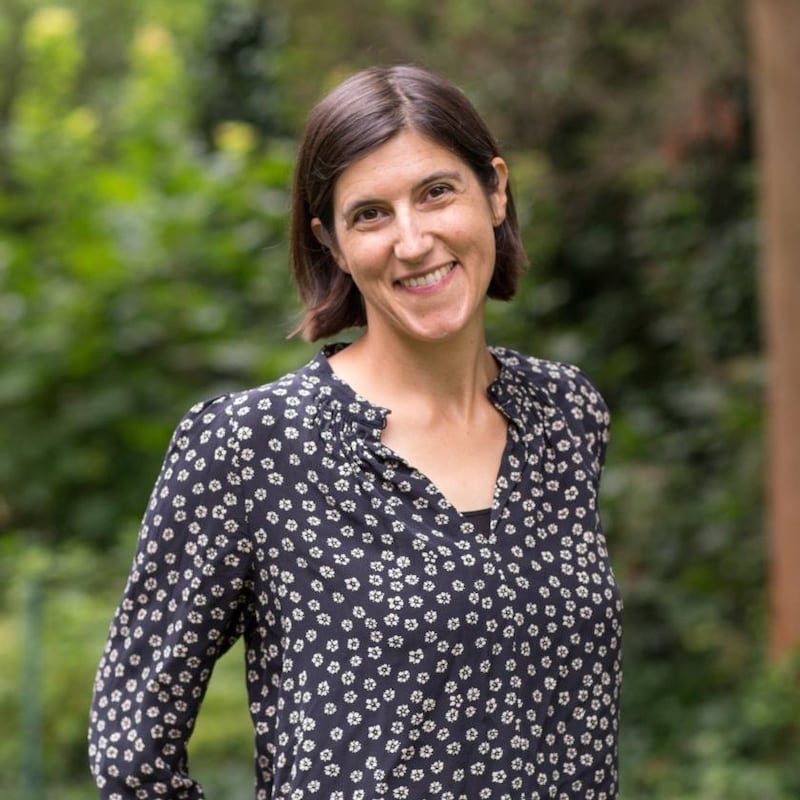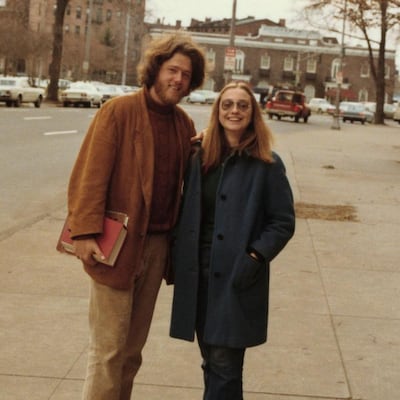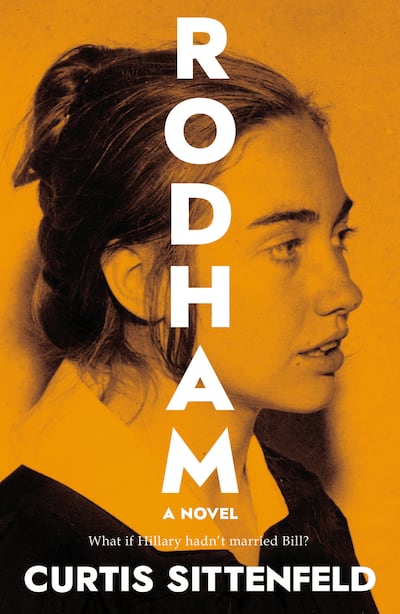In Hillary Rodham Clinton's most recent autobiography, What Happened, the former first lady, US secretary of state and presidential nominee writes: "My marriage to Bill Clinton was the most consequential decision of my life. I said no the first two times he asked me. The third time I said yes. And I'd do it again."
But what if Hillary hadn’t married Bill? What would have “happened” then? These questions are explored with gusto and flair in Curtis Sittenfeld’s brilliant new book, Rodham, her sixth novel. From her home in Minnesota, Minneapolis, via Zoom, the author of the wildly successful debut novel Prep explains her motivation for a book which so boldly rewrites recent American political history.
“I do think the book is, in part, intended to change the outcome of the 2016 election, which I was, you know, horrified by. At this point, maybe I wasn’t sufficiently horrified by it,” she says referencing recent events in her country and the ongoing Trumpocalypse. “There are some people who are so distressed by what happened in 2016 that they might not be able to read a book with Hillary on the cover but those, actually, are the people who would be sort of comforted by it.”
Kids who had known Hillary was running for president often didn't know that Bill Clinton existed... That was the thing that made me write this specific novel
She’s right. If you went to bed with, or woke up to, news of Donald Trump’s election victory and were distraught by the outcome, as many were, Rodham is nothing short of a soothing read. (Those who were happy that Clinton narrowly lost out to Trump, may have a very different experience reading this book.)
Rodham offers the reader an alternative narrative, a chance to ponder how events might have turned out had the famous couple passed through Sittenfeld’s exquisitely drawn sliding doors. At one point in the book, Sittenfeld’s imagined Hillary says “isn’t there a song about thanking God for unanswered prayers . . . is there a parallel universe where I married Bill and if there is, did we stay married?”
The genesis of the idea came from a story Sittenfeld wrote for Esquire magazine called The Nominee, six months before the 2016 election.
“If Hillary had become president I wouldn’t have written Rodham . . . but I had that experience of writing from her point of view, and it was in the back of my head. And then after the election I had this realisation that kids who had known Hillary was running for president often didn’t know that Bill Clinton existed and so I did wonder. That was the thing that made me write this specific novel. What if adults had also seen Hillary as being totally separate from Bill?”
It took her three years to complete the novel which is written in the first person, from the point of view of Hillary Rodham, the Hillary that in Sittenfeld’s fictional retelling never became Hillary Clinton. The book makes for compulsive reading, it’s a bona fide page turner as you race to see how these alternate lives turn out. (In the interest of avoiding spoilers, it’s best to just say that in the absence of Bill, Hillary ends up as a lawyer and eventually enters politics. For everything else, read the book.)

The success of the novel, for this reader, comes from how deftly Sittenfeld pulls off the enormous task of telling a made-up story involving real life characters, people so famous we have a sense of somehow knowing them, in a way that feels plausible.
Much of this is down to the authenticity of Rodham’s voice in the novel. Sittenfeld read books about her subject – Hillary Clinton has written three memoirs – which gave her a deeper sense of the woman but mentions, in terms of helpfulness, a podcast produced by the Clinton Foundation, in which Hillary is clearly very relaxed with the interviewer.
“So I could hear the way she talked when she knew she was in friendly territory, which is so often not the case in interviews where journalists tend to talk to her with scepticism. When you read interviews with her from the fall of 2016 that scepticism is so interwoven into every sentence. And in the absence of that she seemed much more relaxed . . . so after hearing that the voice was something that came easily.”
Am I going to include sex? The answer was yes, because it feels very organic. Then I made peace with those decisions and kept writing
While it was important that the voice was authentic she did not stop after every sentence and say to herself, “does this sound like Hillary? I mean, it’s a novel and so I think it’s understood that liberties are being taken. Creative liberties”.
Those liberties and creative leaps are nowhere more apparent than in her depiction of the prolific sex life of the young lovers. The beginning of the novel is set in Yale Law School where the couple met. (“Oh Bill Clinton’s smile! More than forty-five years have passed since that night in the library, and at times it’s crossed my mind that his smile may have ruined my life,” says Rodham.) It follows pretty faithfully the real life trajectory of the students that were Hillary Rodham and Bill Clinton apart from intimate, unknowable scenes which have to be filled and imagined by the author. Soon after their meeting at Yale, for example, Rodham gets to witness the insatiable appetite of Clinton in a diner, where he devours order after order of French fries, the scene suggests other appetites that cannot be sated. Later we are treated to the image of a young Bill Clinton playing the saxophone naked and an unforgettable sex scene on a road trip to Arkansas that happens while Hillary is driving. (Again, read the book.)
Given what we know about real-life Bill Clinton, was including lots of sex important? “The premise of the book is what if Hillary had said no to Bill’s third proposal and gone her own way . . . in order for it to feel like it mattered [when she said no], they had to convincingly fall in love in the book and it’s supposed to heartbreaking and their physical attraction was a really natural, important part of that story.”
Sittenfeld had a couple of editorial decisions to make early on in the writing of the novel. One was, did she use their real names. She decided it would be “almost too complicated not to”. Another question was “am I going to include sex? The answer was yes, because it feels very organic. Then I made peace with those decisions and kept writing . . . I knew I was inviting this line of questioning by including them but I just felt like it made the novel stronger. And my deepest obligation is to the novel. It’s not to a reviewer. It’s not to Hillary herself. My primary responsibility is to write the best book that I can”.

The result is a Bill Clinton character who comes across as a deeply unlikeable sex addict. “You’re a smug bitch who drives people away because you think you’re smarter than everyone else,” he says to Hillary at one point in Rodham. “Of course you don’t find it hard to be faithful when you don’t have other options”. His infidelity is only one of several reasons Hillary refuses Clinton’s proposal in the book. I ask Sittenfeld about the potential legal problems such speculative fiction might have risked. She says she wrote it knowing the book would be legally reviewed, which it was but “I didn’t go to to law school. I think that some of the ins and outs of what can and can’t be written is almost better explained by a lawyer”.
The book may be about what might have happened if Hillary had turned Bill down, but did Sittenfeld get a sense, during her research, of why Hillary Rodham said yes and ended up getting married to Clinton? “Yes,” she says. “I feel like if it was 1975 and Bill wanted to marry me, I would have said yes. I’ve heard anecdotally, sometimes in real life people plan to not like him then in his presence they just sort of melt at his magnetism and charisma. I think I totally understand why she married him. I don’t think that makes her foolish and I don’t think it was like this feminist failure.” As part of her research, she read the first quarter of Bill Clinton’s 1,000-page autobiography My Life and has said, reading it, she felt herself falling in love with him.
She was interested, she says, in examining the tension between fate and free will and alternate lives. “The margin between staying and leaving was so thin,” Hillary says in the book. “Really it could have gone either way”. When I point out that Bill Clinton does not come out of it well she says “it depends on the page . . . It’s not supposed to be an unequivocal condemnation of Bill Clinton . . . one of the reasons I like reading and writing novels is that they acknowledge how complicated people are, how one person can have appealing qualities and very unappealing qualities. Sometimes in life we don’t acknowledge that but in novels we do”.
This complexity is what makes the characters in Sittenfeld’s books so compelling, from her acclaimed debut Prep about life in an elite American school through to her last book before this one, a stunning collection of short stories called You Think It, I’ll Say It. In real life, she is more interested in people with both “great qualities and off-putting qualities. I probably spend more time thinking about that person than someone who is really nice or someone who is just awful.”
She is obviously fond of Hillary, I suggest, could she have written it if she weren’t? “There is a strange space I have to occupy where I really admire and respect her. But I think if I had written this as a love letter, nobody would have wanted to read it. I think I had to make her flawed and have her make questionable decisions. If I had written this novel where the end goal was for me to meet her and have lunch with her, I think readers would have been put off.”
When I am writing fiction it's like spending time in that person's company. And you know I don't really want to spend time imagining Melania Trump
She doesn’t expect to be asked to lunch or even for the Clintons to read it. The book, she thinks, falls into the category of many articles and books written that will have “rubbed them up the wrong way”. She says this is “a creative artistic project, not a bombshell biography . . . I don’t think they are required to engage with it”. She does, however, know people close to the Clintons who are reading the book.
This is not the first time Sittenfeld has delved into the behind-the-scenes world of a First Lady. American Wife, published 12 years ago, featured Alice Blackwell, who bore many similarities to Laura Bush, wife of George. People have asked whether she’d be interested in exploring the story of another first lady, Melania Trump. “I never would,” she says. “When I am writing fiction it’s like spending time in that person’s company. And you know I don’t really want to spend time imagining Melania Trump or imagining being married to Donald Trump. And also I don’t feel the compassion for her . . . if I don’t admire the subject it could turn into mockery or satire or even a little bit of sadism on my part.”
Sittenfeld grew up in Ohio, attended Vassar College in New York and Stanford University in California and now lives in Minneapolis with her two children and her husband, a professor. She prefers to do audio interviews, she says, but appeared on the Zoom screen when I put the request to her through the book publicist. She’s wearing a grey hoodie and is instantly recognisable if you’re a fan, with her dark hair and glasses. At one point she puts her elbow to her nose, “my first Zoom sneeze”.
“I’m privileged in my education and even in my professional stability in an unstable field,” she says when I ask about the fact that many of her books explore people moving through elite worlds. “I like to think of myself as a class traitor. Like I don’t think I am writing about elite people as a celebration of them, I think it’s the opposite”.
There’s a plot line in the book where Rodham loses a close friendship with a woman of colour because she runs against a black politician for the Senate. “There is a long history of white feminists often failing black feminists in the United States,” says Sittenfeld. “The Clintons have had up and downs and better and worse moments, but race is always such a huge part of the American story. And so it would have been hard to imagine not including a plotline that confronted race and racism.”

We are speaking three weeks after the killing by a police officer of George Floyd in Minnesota. When I mention it, she says it happened not too far from her home. She drops this fact in casually, in the sense that she does not use it for storytelling purposes or to launch into a dramatic response to that incident, and this seems typical of her understated, thoughtful approach.
“The city felt very different for a few days. It still does because a lot of protests are still going on but they seem to get less media attention when they are not violent”. She talks to her children about race and racism, they are nine and eleven, but then she always has. “There is a conversation among white people, some seem to be acting like racism started three weeks ago which is preposterous. Like that seems like a very, very weird perspective to have”.
“It’s a confusing moment in time,” she says. “I think there are reasons to feel both optimistic and pessimistic. I do think that there is more white engagement with white racism than I ever remember in my lifetime and a recognition that this is a huge problem for everyone and that racism is interwoven in our society pretty much everywhere. So I think a lot of reckonings are going on right now and it’s a challenging, uncomfortable moment. But I think good things can come out of that..
She is active on social media. While finishing Rodham last year she tweeted, slightly tongue in cheek: “I seriously think (today anyway) that I may have written the great American novel. You might not realize it because I’m female and because the cover will probably be either a dress or a woman whose face you can’t see, so this is just an FYI.” As it happens the cover is a woman, a very young, attractive Hillary Rodham. Sittenfeld loves the design. But does she see a difference in the way women’s novels are received in America? “I do think that sometimes women writers are not taken as seriously or there is more scepticism about the premise of a book”.
She’s been asked whether Rodham is “fan fiction” – “that depends on your definition” – but her publishers are touting the book as a “literary landmark” and she has deservedly been spoken about in Great American Novelist terms. How does this acclaim sit with her? Does it add pressure? She laughs at the idea.
“I’ve been at home a lot like everybody else. My kids know I am a writer but in terms of my identity here I am, you know, the person who forgot to get orange juice at the grocery store.
“My kids might look at me and say, have you washed your hair lately because it really doesn’t look like it. So I would say I definitely am not burdened by feelings of being like, a prisoner of success. I aspire to be a prisoner of success”.
Rodham: A Novel is published by Doubleday











